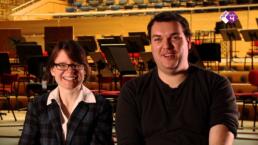Cadenza for Arutyunyan Trumpet Concerto
Details
Duration:
2'
Instrumentation:
trp
Written for:
Peter Masseurs, for Trumpet Concerto of A. Arutyunyan
Ballade
In Theo's Own Words
“The Ballade for trombone and piano was composed in 2016, at the request of Sebastiaan Kemner and Andrea Vasi. The piece has a three-part structure. The loud opening is part of a slow introduction in which the piano plays broken chords as an accompaniment to the trombone’s melodic phrases. This is immediately followed by a fast section, in which the piano part moves to the foreground with a continuous, fast motion. At times, the trombone joins in. The third part is again slow in tempo. The style of this section is derived from the German baroque. The trombone plays a choral melody (O Traurigkeit, o Herzeleid) against the figurative motion of the piano.”
– Theo Verbey
In Concert
06 Apr 2016
10 Apr 2016
13 Apr 2016
15 Apr 2016
Five Pieces for Violoncello
Details
Duration:
8'
Instrumentation:
Solo cello
Commissioned by:
Maarten Mostert and the Dutch National Cello Competition in June 2006
In Theo's Own Words
“Commissioned by Maarten Mostert and the Dutch National Cello Competition in June 2006. The titles of these five short pieces are:
- On Rhythm,
- On Colour,
- On Speed,
- On Intonation,
- On Double Stops.
The subjects are therefor partly musical, and partly technical. In terms of content, these pieces are somewhere between etudes and concert pieces.”
– Theo Verbey
In Concert
Nothing found.
Video
Two movements from '5 Pieces for Violoncello', performed by Martín Álvarez Díaz
5'10"
Perplex
Details
Duration:
14'
Instrumentation:
fl cl vibr pf vl vc
Commissioned by:
Performing Arts Fund NL
Written for:
Musicians of the Deutsche Oper Berlin and November Music
In Theo's Own Words
“The subject of Perplex (l perpléxus = perplexed, confused) is the confrontation of several musical textures. The unison opening is repeated three times in the course of the piece; as an ending of the first and the second part and as start of the fourth part. Aside from this opening, other musical subjects vary with one another. The subjects contrast strongly and are hardly connected. The piece has no transitional stages and a suggesting character. Motifs and phrases are revealed but not developed further in a romantic way. The four components of the piece are in the proportion of themselves in time as 5:7:4:8. These number proportions stipulate at lower levels the mutual length in relation to the individual motifs and phrases. This manner of composing is based on the planned rhythmic structure analogous to the isometrics of the Ars nova analogous (14th Century) with composers like Guillaume de Machaut and Landini. The foundation of the piece is formed by a succession of four chords, which remains unchanged and is invariably repeated. This too, is a process with a long history. These chords have a strongly tonal identity, but cannot be easily placed in a key because the relationship of the chords is unclear. It is only at the end of the piece that freedom is added to this technique. Through the use of three instrumental duos: flute/clarinet, violin/violoncello and vibraphone/piano the piece has a truly own sound with strong percussive character. Vibraphone and piano have a function similar to the continuo section (i.e. the combination of keyboard instrument with a bass instrument) from the Baroque.”
– Theo Verbey
In Concert
Nothing found.
4 Preludes to Infinity
Details
Duration:
11'30''
Instrumentation:
ob, vn, va, vc
Commissioned by:
The Stolz Quartet
Find on CD:
In Theo's Own Words
“The work consists of 4 movements, each separately expressing one possible aspect of infinity. It doesn’t try to define infinity, but to shed light on which facets we are able to differentiate.”
– Theo Verbey
In Concert
26 Mar 2022
24 Mar 2022
30 Aug 2013
07 Sep 2013














